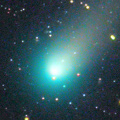
|
It brightened rapidly in outburst in mid October. Now it is bright as 8.3 mag (Mar. 29, Marco Goiato). It keeps 8-9 mag until early summer. In the Northern Hemishpere, it keeps observable in the morning sky until July. In the Southern Hemisphere, it keeps observable in good condition for a long time until the comet fades out.
Date(TT) R.A. (2000) Decl. Delta r Elong. m1 Best Time(A, h)
Mar. 29 20 26.87 -4 8.8 1.905 1.668 61 8.2 4:26 (296, 26)
Apr. 5 20 42.11 -5 20.9 1.876 1.698 64 8.3 4:15 (297, 26)
|
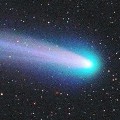
|
It passed only 0.4 A.U. from the earth, and 0.8 A.U. from the sun in November and December, and brightened up to 4.7 mag (Nov. 28, Juan Jose Gonzalez). Now it is 10.6 mag (Mar. 29, Marco Goiato). It keeps observable until 2014 autumn when the comet fades out.
Date(TT) R.A. (2000) Decl. Delta r Elong. m1 Best Time(A, h)
Mar. 29 18 29.25 -5 56.4 1.537 1.839 90 9.9 4:26 (325, 43)
Apr. 5 18 24.26 -7 40.2 1.514 1.932 98 10.1 4:15 (333, 44)
|
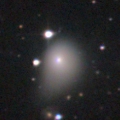
|
Now it is bright as 10.4 mag (Mar. 29, Marco Goiato). The brightening is somewhat slow, but it is expected to brighten up to 6-7 mag in 2014 autumn. It keeps observable in good condition for a long time in the Northern Hemisphere. It keeps locating low in the Southern Hemisphere.
Date(TT) R.A. (2000) Decl. Delta r Elong. m1 Best Time(A, h)
Mar. 29 16 5.73 32 35.1 1.873 2.498 117 10.2 3:42 ( 0, 87)
Apr. 5 15 48.16 36 35.2 1.739 2.416 121 10.0 2:57 (180, 89)
|
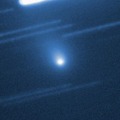
|
New bright comet. Now it is 10.2 mag (Mar. 27, Michael Mattiazzo). It will approach to the sun down to 0.65 a.u. in July, and it is expected to brighten up to 7 mag. Before the perihelion passage, it keeps observable until mid May in the Northern Hemisphere, or until early June in the Southern Hemisphere. After the perihelion passage, it will be observable in excellent condition after late July in the Northern Hemisphere. In the Southern Hemisphere, it keeps unobservable until early September.
Date(TT) R.A. (2000) Decl. Delta r Elong. m1 Best Time(A, h)
Mar. 29 10 23.29 -32 42.7 0.989 1.857 138 10.7 21:52 ( 0, 23)
Apr. 5 9 32.46 -27 22.4 0.958 1.756 127 10.4 20:35 ( 0, 28)
|
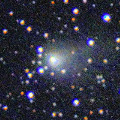
|
First return of a new periodic comet discovered in 1998. It brightened up to 10 mag at the discovery. Now it is 12.7 mag (Mar. 28, Sandor Szabo). A bit fainter than originally expected. But in the Northern Hemisphere, it keeps observable in excellent condition from autumn to spring. It locates somewhat low in the Southern Hemisphere.
Date(TT) R.A. (2000) Decl. Delta r Elong. m1 Best Time(A, h)
Mar. 29 6 55.00 20 1.0 1.834 2.162 94 12.7 19:43 ( 52, 68)
Apr. 5 7 5.22 18 51.4 1.914 2.168 90 12.8 19:50 ( 60, 63)
|
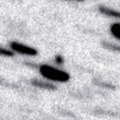
|
The condition in this apparition is bad. It locates low around the brightest days. Now it is not observable. It will appear in the morning sky at 13 mag in late July.
Date(TT) R.A. (2000) Decl. Delta r Elong. m1 Best Time(A, h)
Mar. 29 0 33.30 4 35.1 2.763 1.766 1 12.9 19:43 (108,-16)
Apr. 5 0 51.54 6 7.2 2.743 1.743 0 12.8 4:15 (249,-17)
|
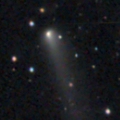
|
Now it is 12.9 mag (Mar. 28, Sandor Szabo). It will brighten up to 13 mag and to be observable in excellent condition from spring to summer.
Date(TT) R.A. (2000) Decl. Delta r Elong. m1 Best Time(A, h)
Mar. 29 14 9.72 -12 45.6 1.677 2.609 153 13.0 1:46 ( 0, 42)
Apr. 5 14 7.83 -12 19.5 1.634 2.600 160 12.9 1:17 ( 0, 43)
|
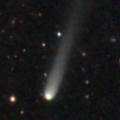
|
Now it is 14.1 mag and visible visually (Feb. 24, Chris Wyatt). It is expected to brighten up to 7.5 mag and to be observable in excellent condition from summer to autumn in 2014 in the Southern Hemisphere. It keeps observable for a long time in the Southern Hemisphere, although it becomes low temporarily in May. It keeps unobservable for a while in the Northern Hemisphere. It will pass extremely close to Mars in 2014 October.
Date(TT) R.A. (2000) Decl. Delta r Elong. m1 Best Time(A, h)
Mar. 29 2 38.70 -26 52.0 3.746 3.097 43 13.5 19:43 ( 64,-10)
Apr. 5 2 40.42 -26 3.4 3.709 3.025 40 13.4 19:50 ( 69,-15)
|
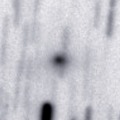
|
It brightened up to 2 mag by unusual major outburst in 2007. It is coming back now. It will be 14 mag at best by normal prediction. But actually, it is already very bright as 13.5 mag (Nov. 25, Hidetaka Sato). Now it is not observable. It will appear in the morning sky in May.
Date(TT) R.A. (2000) Decl. Delta r Elong. m1 Best Time(A, h)
Mar. 29 23 37.98 3 31.7 3.018 2.056 12 13.4 4:26 (260, -8)
Apr. 5 23 51.99 5 41.7 3.003 2.058 15 13.4 4:15 (259, -6)
|

|
New outburst occured in early March. Now it is bright as 13.1 mag (Mar. 12, Chris Wyatt).
Date(TT) R.A. (2000) Decl. Delta r Elong. m1 Best Time(A, h)
Mar. 29 15 57.99 -30 50.1 5.543 6.154 123 13.6 3:34 ( 0, 24)
Apr. 5 15 56.67 -30 55.5 5.453 6.152 130 13.6 3:05 ( 0, 24)
|

|
It brightened up to 11-12 mag in 2012. Now it is 13.7 mag (Mar. 28, Sandor Szabo). It will be observable in good condition at 14 mag until 2014 early summer.
Date(TT) R.A. (2000) Decl. Delta r Elong. m1 Best Time(A, h)
Mar. 29 12 38.15 -11 51.0 6.334 7.322 171 13.8 0:15 ( 0, 43)
Apr. 5 12 32.17 -11 19.8 6.365 7.357 172 13.9 23:37 ( 0, 44)
|
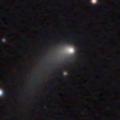
|
Now it is 13.9 mag (Mar. 19, Taras Prystavski). It keeps 14 mag for a long time until 2014 summer. It keeps observable in good condition in the Northern Hemisphere. It keeps unobservable after this in the Southern Hemisphere.
Date(TT) R.A. (2000) Decl. Delta r Elong. m1 Best Time(A, h)
Mar. 29 3 10.63 42 22.2 2.088 1.690 53 13.9 19:43 (122, 33)
Apr. 5 3 21.31 45 18.6 2.121 1.675 50 13.9 19:50 (127, 30)
|

|
Now it is 14.0 mag (Mar. 29, Sandor Szabo). It keeps bright at 13-14 mag for a long time until 2014. It will be getting higher gradually, and it keeps observable for a long time after this.
Date(TT) R.A. (2000) Decl. Delta r Elong. m1 Best Time(A, h)
Mar. 29 19 58.14 4 22.6 6.609 6.298 67 14.1 4:26 (294, 37)
Apr. 5 19 58.08 4 22.0 6.519 6.315 73 14.1 4:15 (298, 40)
|
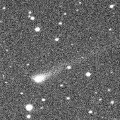
|
Now it is 14.9 mag (Mar. 5, Taras Prystavski). It keeps bright as 13-14 mag for a long time from 2013 to 2014.
Date(TT) R.A. (2000) Decl. Delta r Elong. m1 Best Time(A, h)
Mar. 29 20 11.45 -25 40.5 3.274 3.056 68 14.3 4:26 (315, 13)
Apr. 5 20 20.50 -25 31.4 3.185 3.057 73 14.3 4:15 (316, 14)
|
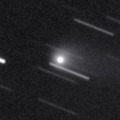
|
Now it is bright as 13.9 mag (Mar. 29, Sandor Szabo). It keeps 13-14 mag and observable in good condition in the Northern Hemisphere for a long time from 2013 to 2014. In the Southern Hemisphere, it is not observable until 2014 autumn.
Date(TT) R.A. (2000) Decl. Delta r Elong. m1 Best Time(A, h)
Mar. 29 0 36.00 53 37.4 4.102 3.551 50 14.4 19:43 (146, 16)
Apr. 5 0 42.73 53 0.5 4.170 3.567 47 14.4 4:15 (215, 15)
|
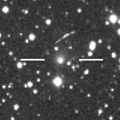
|
Brightening rapidly. Now it is 14.0 mag (Mar. 28, Sandor Szabo). It will brighten up to 13-14 mag and will be observable in excellent condition from spring to summer in the Southern Hemisphere. It locates somewhat low in the Northern Hemispehre.
Date(TT) R.A. (2000) Decl. Delta r Elong. m1 Best Time(A, h)
Mar. 29 7 56.24 -22 26.9 1.562 2.136 111 14.6 19:43 ( 4, 32)
Apr. 5 8 1.81 -21 32.0 1.568 2.101 107 14.4 19:50 ( 12, 33)
|

|
Big asteroid discovered in 1906. It suddenly showed the cometary activity on Dec. 11, 2010, probably due to an impact of a small object. It has already turned to be stellar.
Date(TT) R.A. (2000) Decl. Delta r Elong. m1 Best Time(A, h)
Mar. 29 1 50.91 3 47.8 4.214 3.296 20 15.1 19:43 ( 96, -2)
Apr. 5 1 59.53 4 50.0 4.252 3.302 16 15.0 19:50 (100, -6)
|
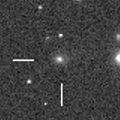
|
It is expected to brighten up to 13 mag and to be observable in good condition in 2015. Now it is 15.5 mag (Mar. 29, Sandor Szabo). In 2014, it will be observable at 15 mag in good condition from winter to summer.
Date(TT) R.A. (2000) Decl. Delta r Elong. m1 Best Time(A, h)
Mar. 29 13 57.41 -2 21.3 3.871 4.812 158 15.3 1:34 ( 0, 53)
Apr. 5 13 55.11 -1 52.6 3.799 4.771 164 15.2 1:04 ( 0, 53)
|
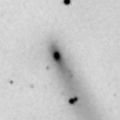
|
Now it is 15.2 mag (Mar. 5, Taras Prystavski), brighter than origianlly predicted. It will be observable at 14-16 mag for a long time from 2013 to 2014.
Date(TT) R.A. (2000) Decl. Delta r Elong. m1 Best Time(A, h)
Mar. 29 16 22.05 -24 33.1 3.474 4.068 120 15.8 3:58 ( 0, 30)
Apr. 5 16 21.81 -24 45.9 3.399 4.081 127 15.7 3:30 ( 0, 30)
|
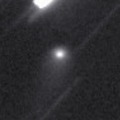
|
It brightened up to 14.0 mag from spring to summer in 2013 (June 11, Sandor Szabo). Now it is 15.2 mag, much brighter than origianlly predicted (Mar. 28, Sandor Szabo). In the Northern Hemisphere, it will be observable at 15-16 mag in excellent condition until spring. It locates somewhat low in the Southern Hemisphere.
Date(TT) R.A. (2000) Decl. Delta r Elong. m1 Best Time(A, h)
Mar. 29 12 39.91 30 52.7 3.538 4.400 145 15.8 0:17 ( 0, 86)
Apr. 5 12 29.24 32 23.6 3.615 4.440 141 15.9 23:33 ( 0, 87)
|
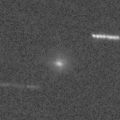
|
Now it is bright as 13.5 mag (Mar. 1, Taras Prystavski). It will be fading rapidly in the evening sky after this.
Date(TT) R.A. (2000) Decl. Delta r Elong. m1 Best Time(A, h)
Mar. 29 4 0.11 12 13.5 1.154 0.968 52 15.8 19:43 ( 84, 30)
Apr. 5 4 41.92 14 15.5 1.205 1.057 56 16.7 19:50 ( 85, 33)
|
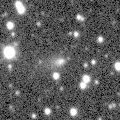
|
Now it is 15.3 mag (Mar. 6, Taras Prystavski). It will be fading gradually after this, and it will be fainter than 18 mag in June.
Date(TT) R.A. (2000) Decl. Delta r Elong. m1 Best Time(A, h)
Mar. 29 6 17.62 29 6.9 1.553 1.785 85 16.0 19:43 ( 84, 66)
Apr. 5 6 35.01 28 6.6 1.619 1.794 82 16.1 19:50 ( 85, 62)
|

|
First return of a new periodic comet which brightened up to 13 mag in 2007. It is expected to brighten up to 13 mag again and observable in good condition from summer to autumn in 2014.
Date(TT) R.A. (2000) Decl. Delta r Elong. m1 Best Time(A, h)
Mar. 29 21 10.87 -11 42.0 3.025 2.528 51 16.2 4:26 (294, 13)
Apr. 5 21 22.95 -10 59.1 2.938 2.509 55 16.0 4:15 (295, 14)
|
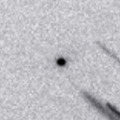
|
Now it is 15.8 mag (Mar. 28, Sandor Szabo). It will approach to the earth down to 0.68 a.u., brighten up to 16 mag, and will be observable in excellent condition in spring.
Date(TT) R.A. (2000) Decl. Delta r Elong. m1 Best Time(A, h)
Mar. 29 11 3.62 10 0.2 0.690 1.649 154 16.1 22:35 ( 0, 65)
Apr. 5 10 51.84 5 51.0 0.714 1.646 147 16.1 21:56 ( 0, 60)
|
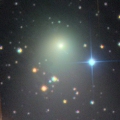
|
It became much brighter than expected, and reached up to 8.5 mag (Aug. 15, Alexandre Amorim). Now it is fading rapidly. It has already faded down to 15.5 mag (Mar. 5, Taras Prystavski). In the Southern Hemisphere, it will keep observable in good condition for a long time until 2014 summer when the comet fades out. It will never be observable again in the Northern Hemisphere.
Date(TT) R.A. (2000) Decl. Delta r Elong. m1 Best Time(A, h)
Mar. 29 17 5.22 -71 29.8 2.910 3.230 99 16.1 4:26 (359,-17)
Apr. 5 16 54.41 -71 45.9 2.901 3.300 104 16.3 4:04 ( 0,-17)
|
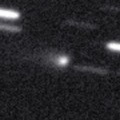
|
Now it is 16.6 mag (Feb. 20, Katsumi Yoshimoto). It is expected to brighten up to 6 mag in 2014 autumn. At this time, it keeps observable while brightening gradually until April when it becomes 16 mag.
Date(TT) R.A. (2000) Decl. Delta r Elong. m1 Best Time(A, h)
Mar. 29 4 50.45 19 11.1 3.317 3.044 65 16.4 19:43 ( 84, 43)
Apr. 5 4 49.81 18 58.6 3.353 2.956 58 16.3 19:50 ( 89, 36)
|
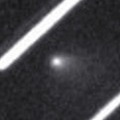
|
Now it is 15.1 mag (Mar. 11, Catalina Sky Survey). It is observable at 15-16 mag in excellent condition at opposition in March. But it will fade out very rapidly after that. It will be fainter than 18 mag in May.
Date(TT) R.A. (2000) Decl. Delta r Elong. m1 Best Time(A, h)
Mar. 29 12 37.05 17 25.8 1.096 2.061 159 16.3 0:16 ( 0, 72)
Apr. 5 11 58.24 23 9.6 1.183 2.099 147 16.6 23:00 ( 0, 78)
|
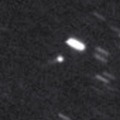
|
Now it is 16.5 mag (Mar. 24, D. Buczynski). It will approach to the earth down to 0.06 a.u. from May to June, and it is expected to brighten up to 11 mag. In the Northern Hemisphere, it keeps observable in excellent condition until the highlight in late May while the comet will be brightening rapidly. In the Southern Hemisphere, it is not observable now. But it will be observable in mid May. Then it keeps observable in excellent condition at the highlight and after that while the comet will be fading.
Date(TT) R.A. (2000) Decl. Delta r Elong. m1 Best Time(A, h)
Mar. 29 6 53.03 72 52.4 0.507 1.109 88 16.6 19:43 (171, 51)
Apr. 5 7 2.11 72 28.7 0.467 1.066 84 16.4 19:50 (168, 50)
|
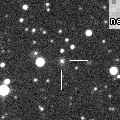
|
Now it is 15.9 mag (Mar. 6, Taras Prystavski). It keeps 16 mag for a long time until 2015 summer. It keeps observable in good condition in the Northern Hemisphere. It becomes observable only after 2015 in the Southern Hemisphere.
Date(TT) R.A. (2000) Decl. Delta r Elong. m1 Best Time(A, h)
Mar. 29 5 8.68 52 16.9 4.085 3.950 75 16.5 19:43 (133, 54)
Apr. 5 5 17.75 52 12.4 4.139 3.922 70 16.5 19:50 (132, 50)
|
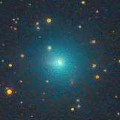
|
It brightened very rapidly, and brightened up to 10.5 mag from autumn to winter. Now it is fading. It has already faded down to 17.3 mag (Mar. 23, A. Klotz, F. Kugel). However, Sandor Szabo reported it was visible visually at 13.5 mag on Mar. 28. In the Northern Hemisphere, it keeps observable in excellent condition until May when it becomes fainter than 18 mag. It will not be observable after this in the Southern Hemisphere.
Date(TT) R.A. (2000) Decl. Delta r Elong. m1 Best Time(A, h)
Mar. 29 3 58.22 35 17.8 2.317 1.976 57 16.6 19:43 (110, 40)
Apr. 5 4 19.04 35 36.3 2.412 2.018 55 16.8 19:50 (111, 37)
|
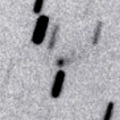
|
Now it is 16.7 mag (Mar. 11, Catalina Sky Survey). It keeps 16.5 mag until June.
Date(TT) R.A. (2000) Decl. Delta r Elong. m1 Best Time(A, h)
Mar. 29 14 35.42 -8 11.8 1.261 2.175 148 16.9 2:12 ( 0, 47)
Apr. 5 14 31.75 -8 56.7 1.213 2.165 155 16.8 1:41 ( 0, 46)
|
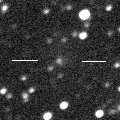
|
Now it is 17.9 mag (Mar. 9, W. Hasubick). Distant object, but it keeps observable at 14 mag for a long time from 2015 to 2016.
Date(TT) R.A. (2000) Decl. Delta r Elong. m1 Best Time(A, h)
Mar. 29 19 14.29 -4 23.1 7.455 7.332 79 17.0 4:26 (312, 38)
Apr. 5 19 16.40 -4 5.0 7.315 7.299 85 17.0 4:15 (315, 41)
|
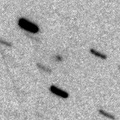
|
Now it is 17.2 mag (Feb. 24, A. Klotz, F. Kugel). It keeps close to the earth around 0.7 a.u. until spring. It will brighten up to 17 mag in February and March, and will be observable in excellent condition in the Northern Hemisphere. It locates very low in the Southern Hemisphere.
Date(TT) R.A. (2000) Decl. Delta r Elong. m1 Best Time(A, h)
Mar. 29 6 50.76 31 7.0 0.673 1.232 92 17.0 19:43 ( 81, 73)
Apr. 5 7 28.57 28 19.1 0.711 1.272 94 17.3 19:50 ( 71, 73)
|

|
Now it is 17.5 mag (Mar. 1, A. Klotz, F. Kugel). It keeps 17 mag for a long time from 2014 to 2015. It is observable in excellent condition in the Northern Hemisphere. It is observable only until 2014 summer in the Southern Hemisphere.
Date(TT) R.A. (2000) Decl. Delta r Elong. m1 Best Time(A, h)
Mar. 29 16 18.29 18 27.8 3.761 4.343 119 17.3 3:54 ( 0, 73)
Apr. 5 16 18.09 20 22.3 3.680 4.316 123 17.2 3:26 ( 0, 75)
|
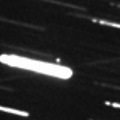
|
Now it is 17.4 mag (Jan. 27, iTelescope Observatory, Siding Spring). It keeps 17-18 mag for a long time from 2013 to 2014. It is observable in excellent condition in the Southern Hemisphere. It is not observable in the Northern Hemisphere.
Date(TT) R.A. (2000) Decl. Delta r Elong. m1 Best Time(A, h)
Mar. 29 13 19.89 -58 35.0 4.050 4.678 123 17.2 0:57 ( 0, -4)
Apr. 5 13 1.43 -59 8.0 4.012 4.680 126 17.2 0:11 ( 0, -4)
|
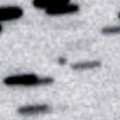
|
Now it is 16.9 mag (Mar. 6, A. Klotz, F. Kugel). It keeps 17-18 mag for a long time from 2014 to 2016.
Date(TT) R.A. (2000) Decl. Delta r Elong. m1 Best Time(A, h)
Mar. 29 15 4.24 -13 2.5 4.952 5.758 140 17.3 2:41 ( 0, 42)
Apr. 5 14 56.77 -12 54.2 4.857 5.739 149 17.2 2:06 ( 0, 42)
|

|
Now it is 17.2 mag (Mar. 12, W. Hasubick). It keeps observable at 18 mag for a long time from 2013 to 2016. It keeps locating high in the Northern Hemisphere. It keeps locating very low in the Southern Hemipshere.
Date(TT) R.A. (2000) Decl. Delta r Elong. m1 Best Time(A, h)
Mar. 29 19 16.47 36 17.1 6.658 6.535 78 17.3 4:26 (257, 61)
Apr. 5 19 15.58 37 39.7 6.586 6.529 82 17.2 4:15 (255, 64)
|

|
It brightened up to 9 mag at the discovery in 2005. It will approach to the sun down to 0.8 a.u. on May 29. However, it will brighten up to 14 mag at best. In this apparition, it keeps observable in the morning sky all through the period. But it locates extremely low around the perihelion passage in the Northern Hemisphere.
Date(TT) R.A. (2000) Decl. Delta r Elong. m1 Best Time(A, h)
Mar. 29 19 31.01 -17 35.4 0.998 1.234 76 18.1 4:26 (317, 25)
Apr. 5 20 9.84 -16 25.0 0.937 1.166 73 17.4 4:15 (312, 23)
|
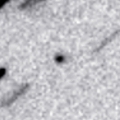
|
It was observed at 17.5 mag in early 2013. It will be observable at 17.5 mag again from spring to summer in 2014.
Date(TT) R.A. (2000) Decl. Delta r Elong. m1 Best Time(A, h)
Mar. 29 19 9.08 -13 48.9 2.705 2.736 81 17.5 4:26 (320, 31)
Apr. 5 19 16.82 -13 33.0 2.629 2.749 86 17.5 4:15 (322, 33)
|
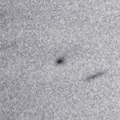
|
Now it is 17.6 mag (Mar. 10, Ken-ichi Kadota). It keeps 17 mag for a long time until 2015.
Date(TT) R.A. (2000) Decl. Delta r Elong. m1 Best Time(A, h)
Mar. 29 10 55.36 -8 29.6 2.607 3.542 156 17.6 22:28 ( 0, 46)
Apr. 5 10 51.93 -7 58.0 2.629 3.527 149 17.6 21:57 ( 0, 47)
|
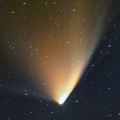
|
It passed the perihelion on 2013 Mar. 10, and brightened up to 0-1 mag. Now it is fading. It has already faded down to 16.9 mag (Mar. 11, Katsumi Yoshimoto). It will keep 16-17 mag until spring. It is not observable in the Southern Hemisphere.
Date(TT) R.A. (2000) Decl. Delta r Elong. m1 Best Time(A, h)
Mar. 29 17 18.18 34 49.8 5.220 5.525 102 17.7 4:26 (270, 84)
Apr. 5 17 15.13 35 41.0 5.231 5.595 106 17.8 4:15 (248, 88)
|
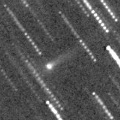
|
New bright comet discovered in the STEREO spacecraft images. It brightened up to 3.8 mag on Jan. 31 thanks to the forward scattering. It approached to the Sun down to 0.5 a.u. on Feb. 18. It was observed at 15 mag on the ground. Now it is fading. But it is still bright as 16.0 mag (Mar. 20, Taras Prystavski). In the Southern Hemispehre, it will not observable after this. Colin Drescher reported the comet was visible on SWAN images for several days in late December at about 11 mag.
Date(TT) R.A. (2000) Decl. Delta r Elong. m1 Best Time(A, h)
Mar. 29 3 46.88 44 8.4 1.013 1.000 59 17.7 19:43 (121, 40)
Apr. 5 4 29.87 39 59.7 1.237 1.119 58 18.9 19:50 (115, 41)
|
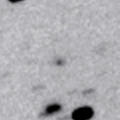
|
Now it is 18.3 mag (Mar. 6, J.-F. Soulier). It keeps 18 mag for a very long time from 2013 to 2018. It locates high in the Southern Hemisphere. But it locates somewhat low in the Northern Hemisphere.
Date(TT) R.A. (2000) Decl. Delta r Elong. m1 Best Time(A, h)
Mar. 29 11 1.05 -18 23.6 8.428 9.332 153 17.8 22:34 ( 0, 37)
Apr. 5 10 59.46 -18 5.3 8.453 9.327 149 17.8 22:05 ( 0, 37)
|
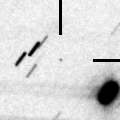
|
Now it is 18.3 mag (Jan. 25, iTelescope Observatory, Siding Spring). It keeps 18 mag from spring to summer. It is observable in good condition in the Southern Hemisphere. It is not observable in the Northern Hemisphere.
Date(TT) R.A. (2000) Decl. Delta r Elong. m1 Best Time(A, h)
Mar. 29 16 19.51 -61 58.3 0.634 1.334 107 17.9 3:55 ( 0, -7)
Apr. 5 16 40.58 -63 50.1 0.637 1.354 109 17.9 3:49 ( 0, -9)
|

|
It was observed at 18 mag in 2013 summer. It is observable at 18 mag until summer also in 2014.
Date(TT) R.A. (2000) Decl. Delta r Elong. m1 Best Time(A, h)
Mar. 29 16 25.49 12 0.3 6.969 7.510 119 18.0 4:01 ( 0, 67)
Apr. 5 16 22.20 12 59.1 6.891 7.513 125 17.9 3:31 ( 0, 68)
|
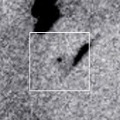
|
Now it is 19.3 mag (Mar. 9, A. Klotz, F. Kugel). First return of a new periodic comet which brightened up to 13 mag in outburst in 2008. It will be observable in good condition from spring to summer. However, it will be only 19-20 mag at best in this apparition.
Date(TT) R.A. (2000) Decl. Delta r Elong. m1 Best Time(A, h)
Mar. 29 12 31.18 14 59.2 1.566 2.533 161 19.5 0:08 ( 0, 70)
Apr. 5 12 26.07 15 28.3 1.565 2.518 157 19.5 23:31 ( 0, 70)
|
|
![]()
 124P/Mrkos
124P/Mrkos C/2012 V2 ( LINEAR )
C/2012 V2 ( LINEAR ) C/2013 V5 ( Oukaimeden )
C/2013 V5 ( Oukaimeden ) C/2014 C3 ( NEOWISE )
C/2014 C3 ( NEOWISE ) 209P/LINEAR
209P/LINEAR C/2013 V2 ( Borisov )
C/2013 V2 ( Borisov ) 154P/Brewington
154P/Brewington P/2014 E1 ( Larson )
P/2014 E1 ( Larson ) C/2011 KP36 ( Spacewatch )
C/2011 KP36 ( Spacewatch ) P/2013 TL117 ( Lemmon )
P/2013 TL117 ( Lemmon ) C/2013 G3 ( PanSTARRS )
C/2013 G3 ( PanSTARRS ) C/2013 G7 ( McNaught )
C/2013 G7 ( McNaught ) C/2013 G9 ( Tenagra )
C/2013 G9 ( Tenagra ) C/2012 K8 ( Lemmon )
C/2012 K8 ( Lemmon ) P/2005 JQ5 ( Catalina )
P/2005 JQ5 ( Catalina ) 280P/2013 C1 ( Larsen )
280P/2013 C1 ( Larsen ) 299P/2014 D2 ( Catalina-PanSTARRS )
299P/2014 D2 ( Catalina-PanSTARRS ) C/2011 L4 ( PanSTARRS )
C/2011 L4 ( PanSTARRS ) C/2014 C2 ( STEREO )
C/2014 C2 ( STEREO ) C/2013 C2 ( Tenagra )
C/2013 C2 ( Tenagra ) 294P/2013 X2 ( LINEAR )
294P/2013 X2 ( LINEAR ) C/2013 H2 ( Boattini )
C/2013 H2 ( Boattini ) 297P/2014 D1 ( Beshore )
297P/2014 D1 ( Beshore )![]()











































